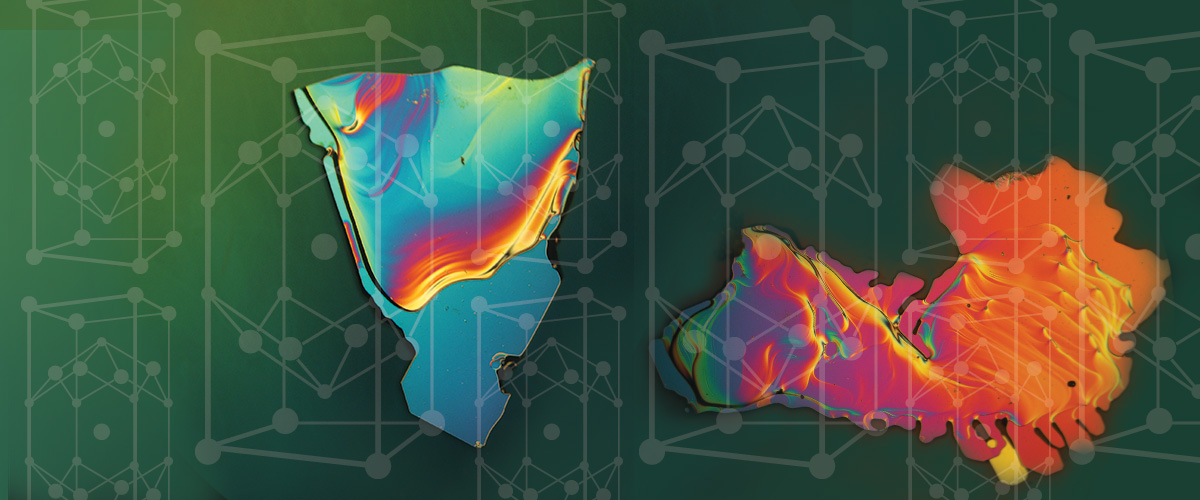Anomalous Correlated Electron Metals
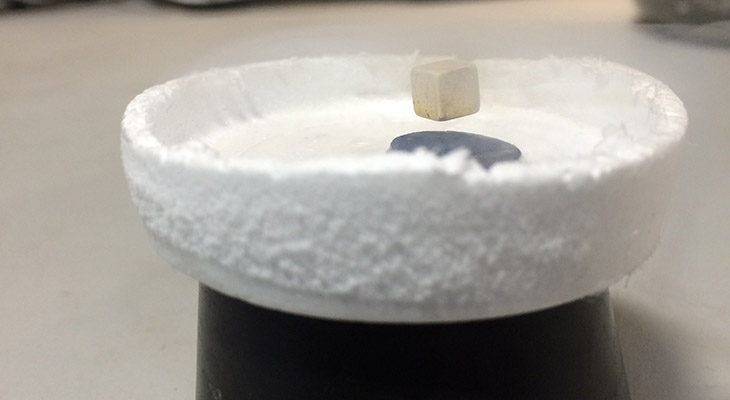
During the last several decades, we have recognized that the anomalous correlated electron metals are one of the frontier for discoveries in the 21st century.
These materials exhibit a breakdown of Fermi liquid behavior, non-phonon mediated superconductivity, anomalous ordered states, and span a broad chemical-structural phase space (e.g., cuprates, pnictides, heavy fermions, ruthenates, and iridates). In general, the rich variety of ground states that appear in these materials arise from finely tuned energy scales: e.g., the competition between the RKKY interaction and the Kondo effect underpins much of the physics that is observed in f-electron materials that include cerium, ytterbium, and many of the 5f elements. The depth of these materials calls for a focused effort to disentangle their universal phenomena from the multiplicity of the effects of quality and composition. Research in this field is central for driving discovery of new materials with new states of matter that arise from complex electronic interactions. In addition, this approach is likely produce new exotic superconductors with potential for energy and technology applications.
Related Publications
- Quantum critical fluctuations in the heavy fermion compound Ce (Ni0. 935Pd0. 065) 2Ge2
- CeCu 2 Ge 2: Challenging our understanding of quantum criticality
- Suppression of antiferromagnetism by pressure in CaCo 2 P 2
- CeIrIn 5: Superconductivity on a magnetic instability
- Hole doping effect on superconductivity in Ce (Co 1− x Ru x) In 5
- Pressure phase diagram and quantum criticality of CePt 2 In 7 single crystals
- Ferromagnetic quantum critical point in UCo 1− x Fe x Ge
Hidden Order in URu2Si2
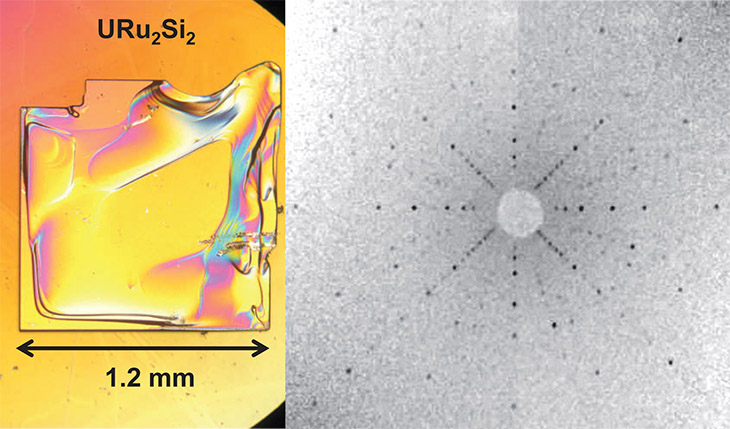
URu2Si2 is an outstanding condensed matter system, and has been a central topic in the field of strongly correlated electrons for the past three decades.
Discovered around the same time as the cuprate superconductors, both of these systems have been on the leading edge of advances in crystal growth and novel measurement techniques and have attracted attention from overlapping groups in the theory community. The physics of URu2Si2 covers a broad range of phenomena including, heavy fermion physics, spin and valence fluctuation behavior, collective non-integer valence states, a transition into an unknown broken symmetry state - so called "hidden order," anomalous non-Fermi liquid metallic behavior, unconventional superconductivity, and possibly multiple distinct superconducting phases. However, in spite of three decades of intense research, the ordered states in this compound (particularly hidden order) have yet to be well understood. We are particularly interested in tuning the ordered ground states (e.g., using applied pressure and chemical substitution) in order to disentangle the multitude of energy scales that may be responsible for the behavior in this compound. These efforts are relevant to developing new materials with unexpected ordered states and for advancing our knowledge of unconventional superconductivity.
Publications
- Chirality density wave of the "hidden order" phase in URu2Si2
- High purity specimens of URu2Si2 produced by a molten metal flux technique
- Evidence for a nematic component to the Hidden Order parameter in URu2Si2 from differential elastoresistance measurements
- Bulk evidence for a time-reversal symmetry broken superconducting state in URu2Si2
- Absence of a static in-plane magnetic moment in the 'hidden-order' phase of URu2Si2
Strategies to search for new crystalline materials with emergent states
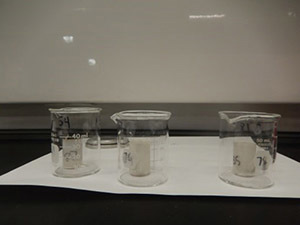 Given that the alphabet of the periodic table can be used to write a nearly limitless variety of structural/chemical stories, it is essential to impose strategies to uncover materials with new states of matter and to address specific physics problems.
Given that the alphabet of the periodic table can be used to write a nearly limitless variety of structural/chemical stories, it is essential to impose strategies to uncover materials with new states of matter and to address specific physics problems.
An essential ingredient for correlated electron materials is to include elements that are favorable for hybridization between localized states and conduction electrons. This is accomplished by investigating materials that include 4f or 5f electron elements with multiple valences (Ce, Pr, Sm, Eu, Tm, Yb, U, Np, and Pu) or d-electron elements with a tendency towards electronic localization (e.g., 1st row transition metals). Electronic correlations may also be enhanced by two dimensional confinement: therefore, layered structures are preferred. We further emphasize that much of our insight into such materials is provided by well-developed tuning studies. As such, it is required to have a strategy for tuning new materials (e.g., using applied pressure, chemical substitution, and magnetic fields). In our research program, we seek to close the loop between these stages of research. In addition to correlated electron systems, we are currently investigating topological states of matter, unconventional superconductivity, and thermoelectric materials - all of which call for individual strategies.
Related Publications
- Complex magnetism and strong electronic correlations in Ce 2 PdGe 3
- Single crystal study of antiferromagnetic CePd3Al9
- Pressure tuned ferromagnetism in CeRu2M2X (M= Al, Ga; X= B, C)
- Local moment ferromagnetism in CeRu2Ga2B
- CeRu 2 Al 2 B: A local-moment 4 f magnet with a complex T-H phase diagram
Synthesis of Ultra High Purity Intermetallic Single Crystals
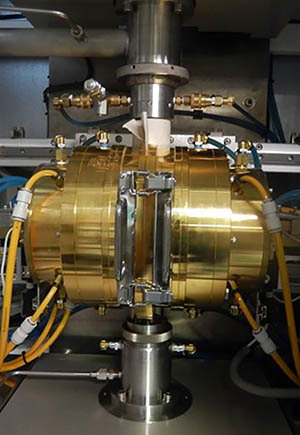 A challenge in studying condensed matter systems is to measure the intrinsic properties of a given compound, since chemical/structural disorder can often hide fundamental behavior. As such, many recent advances in our field stem from the relationship between advanced measurement techniques and improved sample quality.
A challenge in studying condensed matter systems is to measure the intrinsic properties of a given compound, since chemical/structural disorder can often hide fundamental behavior. As such, many recent advances in our field stem from the relationship between advanced measurement techniques and improved sample quality.
An example of a well-known material that has benefitted from advances in crystal growth technology is URu2Si2. This compound exhibits an ordered state (“hidden order”) for which the order parameter has not been unambiguously identified, despite three decades of intense research. A solution to the hidden order conundrum may finally be in sight, owing largely to the development of techniques to produce UHP specimens of this material. Another example is that of the correlated electron metals CeTIn5 (T = Co, Rh, Ir), where characterization of the Fermi surface (e.g., using de Haas van Alphen effect, scanning tunneling microscopy, and angle resolved photoemission spectroscopy) was recently enabled by UHP single crystal specimens. To address related challenges in other materials, we are undertaking a program to synthesize UHP samples for in-house and collaborative studies. In particular, we focus on advanced molten metal flux growth techniques and floating zone image furnace techniques for intermetallics.
Related Publications
- High purity specimens of URu2Si2 produced by a molten metal flux technique
- Visualizing nodal heavy fermion superconductivity in CeCoIn5
- Visualizing heavy fermions emerging in a quantum critical Kondo lattice
Topological States of Matter
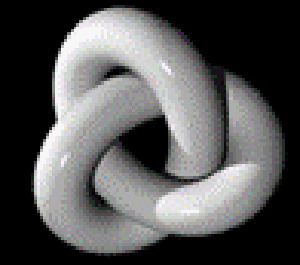 A topological insulator is a time reversal symmetry preserving material with a non-trivial topological order, which behaves as an insulator in the bulk although its surface is conducting.
A topological insulator is a time reversal symmetry preserving material with a non-trivial topological order, which behaves as an insulator in the bulk although its surface is conducting.
While ordinary band insulators can also support conductive surface states, the surface states of topological insulators are distinct since they are symmetry protected through particle number conservation and time reversal symmetry. Topological insulators may provide new routes to search for exotic phenomena and particles, such as spin-polarized massless Dirac fermions or Marjorana fermions at topological insulator/superconductor interfaces, which may drive technological innovations such as spintronic devices and topological qubits for quantum computing. However, nontrivial surface states are difficult to separate experimentally from bulk impurity conduction in non-interacting TIs. In order to address these (and other) challenges, we are currently undertaking to study new families of possible topological insulators, including three-dimensional TIs, cubic Kondo insulators, and magnetically frustrated systems.



